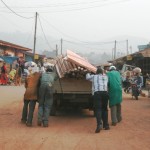I figure there are probably some folks hankering for a recounting and a few pictures of the trip to Cameroon. I figure there’s no way I could tell the whole story in one post. Probably, I could tell it in three to six posts, but that would take some serious time too. Instead, I think I’ll let the story out in the form of anecdotes as they come to me. Herewith is part 1 of at least 2.
When we first got to Cameroon, Terry and Tom swapped out the spring steel right landing gear leg of Tom’s Glasair Sportsman (N211PH). Then we attempted to get her running. Amongst other problems, the battery was dead, so we went to town to seek a battery that would fit an airplane. Keep in mind, that this is a country, larger than California, that boasts around 15 airplanes. Naturally we went to the motorcycle battery store to look for the proper size and voltage cell for an airplane.
Well, would you believe that in a city of 500,000 it took us half of the day to find the only battery in town with the right length and width, but it was to high? And would you believe that the fellow who aided us in our search offered to cut the top off the battery and shorten it for us? As you will read in part 2, I found that these Cameroonians are skilled at salvaging parts, so I believe he would have done it and done it well too. Since it was for an airplane, however, we declined.
In the end, N37JN had to ride the pines so N211PH could use her battery. The latter was a larger ship and could transfer people and supplies much quicker.






